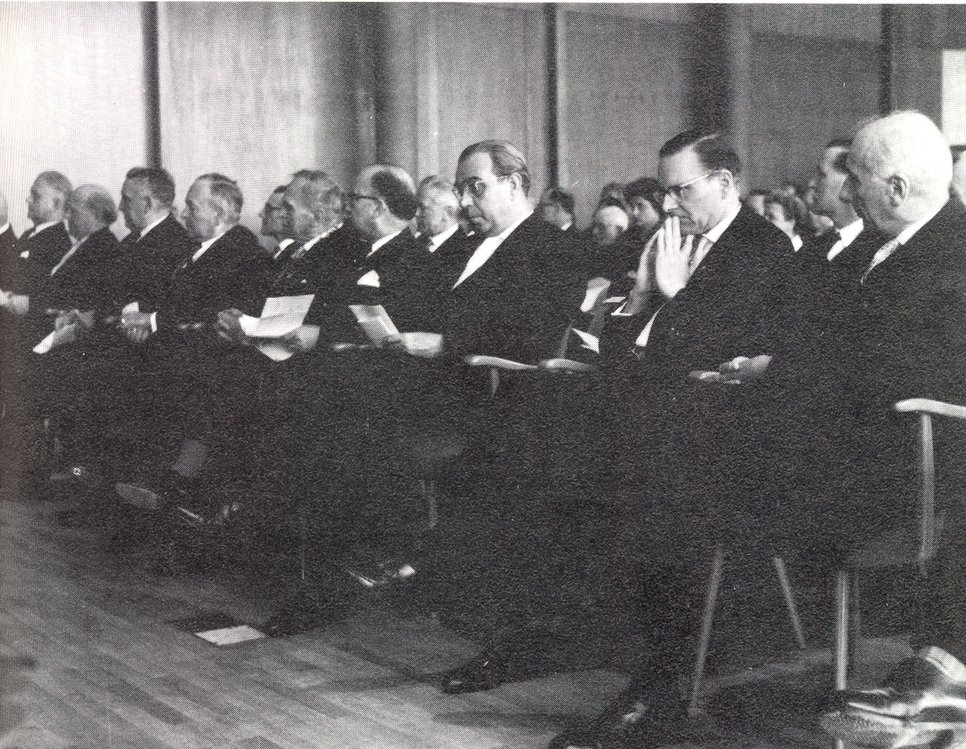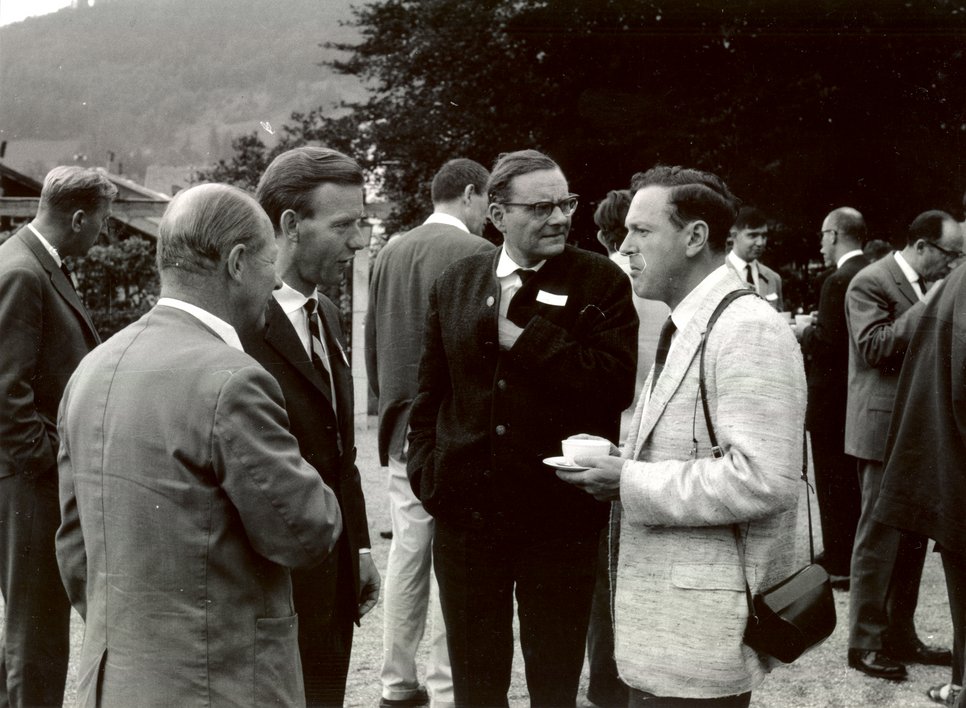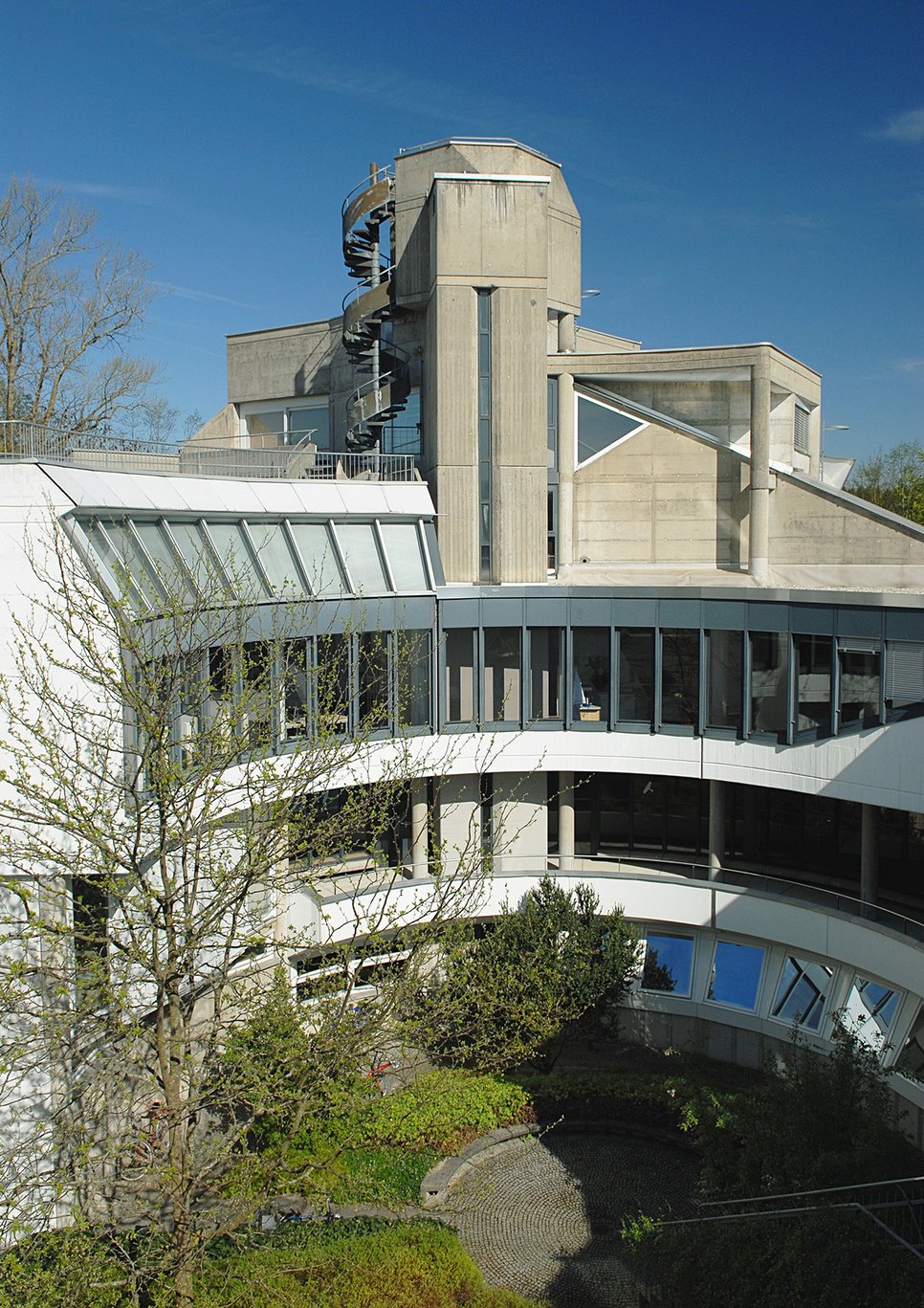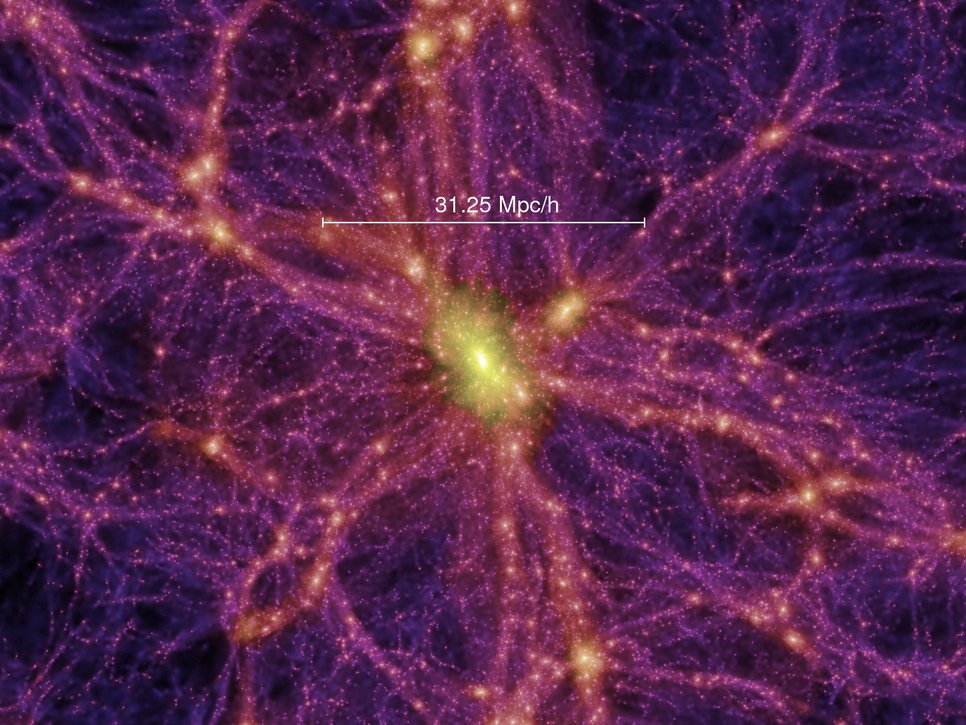50 Years of Theoretical Astrophysics
An excerpt from the brochure commemorating the 50th anniversary in 2008
The Founding Years under the Direction of Ludwig Biermann
The Max Planck Institute for Astrophysics (MPA) was founded in 1958 as an independent offshoot of the Max Planck Institute for Physics and Astrophysics. The first director of the new institute was Ludwig Biermann, who in the preceding years had used all his power to convince responsible persons in the Max Planck Society that the theoretical astrophysics needed an own research facility. Like all of the ca. 80 autonomous institutes of the Max Planck Society, the Institute for Astrophysics is principally dedicated to basic research. From the beginning the strong emphasis on theoretical questions was a distinguishing feature of the MPA: Most other research facilities combine observation and theory.

The foundation was accompanied by relocation: Because the premises in the former Aerodynamics Laboratory in Göttingen had become too small, the Institute for Physics under the direction of Werner Heisenberg and the MPA moved from Göttingen to Munich, at first into a new building in the north. The newly founded MPA then comprised four departments, each led by a Scientific Member of the Max Planck Society: Theoretical Astrophysics (Reimar Lüst), Quantum Mechanics (Eleonore Trefftz), Numerical Computing Machines (Heinz Billing) and Theoretical Plasma Physics (Arnulf Schlüter). The work of the former astrophysics department of the parent institute was continued in these four research groups and over the years broadened by new topics.
The Numerical Computing Machines group addressed themselves to a completely new project: an attempt to repeat Joseph Weber’s famous gravitational wave experiment at the University of Maryland. Weber was convinced that his instruments, which were big metal cylinders with attached, hypersensitive strain detectors, had unambiguously registered gravitational waves, and so proven their existence. Billing and his colleagues were not able to reproduce the sensational Maryland results – not surprisingly, considering the theoretical detection sensitivity of this kind of detector. The group around Billing then turned to more sensitive, interferometric detectors for gravitational waves, which culminated in the installation and operation of an interferometer at MPA with 30m arm length. These early MPA efforts were essential for the later development of instrumentation in this field, and they were continued and greatly extended at the Max Planck Institute of Quantum Optics in Munich and at the Max Planck Institute for Gravitational Physics in Potsdam (the Albert Einstein Institute, which was founded in 1995 as an MPA off-shoot). Ultimately, these led to the 600m gravitational wave detector GEO600.
The department of Theoretical Plasma Physics dealt with the characteristics of ionised gases, the significance of which had become apparent during the preceding years. Important research objects from the beginning were the cosmic magnetic fields, to be found in stars, accretion discs and galaxies. The corresponding theory of magnetohydrodynamics also plays an important role in nuclear fusion experiments. These studies finally led to the first spin-off from the Max Planck Institute for Physics and Astrophysics: In 1960 the Institute for Plasmaphysics was founded and incorporated into the Max Planck Society in 1971.
Another development took place, which finally led to the foundation of a new institute. As early as 1950 Ludwig Biermann had inferred from the deflection of plasma tails of comets that a particle beam emanates from the Sun, the so-called solar wind. Because the processes in the tails of comets are very complicated, the idea came up to generate an artificial tail. This experiment in 1963 was the origin of the Max Planck Institute for extraterrestrial Physics (MPE), led by Reimar Lüst, originally another offshoot of the Institute for Physics and Astrophysics. In its starting years it investigated extraterrestrial plasmas and the magnetosphere of the earth; later the institute concentrated on astrophysical observations in the infrared, X-ray and gamma band.

After Reimar Lüst had left, Rudolf Kippenhahn took over the Theoretical Astrophysics department of the MPA. At that time the first bigger computing machines became available, and Kippenhahn used them to investigate the structure and evolution of stars. Together with his collaborators Emmi Hofmeister and Alfred Weigert he succeeded in identifying the main features of stellar evolution and recorded them in an actual code. In 1965 Rudolf Kippenhahn was appointed to the University of Göttingen, but as scientific member he stayed closely connected to the institute. Hermann Schmidt and Friedrich Meyer assumed the Theoretical Astrophysics department.
Due to the discovery of background radiation and so far unknown cosmic objects like quasars and pulsars, the interest in cosmology and relativistic astrophysics grew. Jürgen Ehler’s appointment as scientific member to the institute was associated with the foundation of a new department for relativistic astrophysics dealing with fundamental questions of gravitational theory and its meaning for the physics of neutron stars and black holes as well as gravitational lenses. Later, in 1995, Jürgen Ehlers was appointed founding director of the MPI for Gravitational Physics and together with his collaborators moved to Potsdam.
On April 1st, 1975 Ludwig Biermann retired. The MPA founding director, who had built up the institute and led it for 17 years, after his retirement continued to work until several weeks before his death on January 12th, 1986. For his ground-breaking scientific achievements he won numerous awards, including the gold medal of the Royal Astronomical Society (1974) and, posthumously, the Cospar Award (1986).
Unexpected Challenges and a Crisis

Rudolf Kippenhahn succeeded Biermann as director. He brought along a new style of leadership by respecting the autonomy of the scientist and emphasizing the individual personality of the researchers above the group. With his pioneering work on the field of the formation of stars he laid the foundations for a long tradition at MPA.
Kippenhahn’s collaborator Achim Weiss followed in his footsteps and has been investigating the evolution of stars and binaries up to today. Together with his group he showed how new observations of star clusters allow to draw conclusions as to their age and to gain insights into elemental abundances. By linking modern calculations of stellar evolution with observations of very old stars the scientists succeeded in identifying the amount of lithium produced by the Big Bang and to derive from this the cosmological density of ordinary matter.
In 1978 Wolfgang Hillebrandt came to the institute and built up a new group for nuclear astrophysics. Together with Ewald Müller he set out to develop models for gravitational collapse supernovae. In 1985 Wolfgang Hillebrandt was appointed scientific member.
In 1979 the institute, which had grown markedly over the years, moved into a bigger building designed by the architects Fehling and Gogel, in close vicinity to the new ESO (European Southern Observatory) headquarters on the Garching campus to the north of Munich. In the following decades one of the leading research centres of Europe developed in Garching, and ESO, MPA and MPE today form the largest agglomeration of excellent astrophysical research capacities in Europe.

In 1991 the Institute for Physics and Astrophysics was divided into three autonomous Max Planck Institutes: the Institutes for Physics, Astrophysics (MPA) and extraterrestrial Physics (MPE). In the same year Rudolf Kippenhahn retired, and this led to a period of uncertainty, because no successor was found at the right time. Wolfgang Hillebrandt took over the provisional direction of the institute. According to MPG rules, however, it was necessary to find an external scientist as director.
Unfortunately Kippenhahn’s retirement also coincided with the German reunification, and in the following years the Max Planck Society was very active in the foundation of new institutes in Eastern Germany. To raise funds, other institutes were closed down, and this was discussed for MPA as well.
A new Start under altered Circumstances
At last the end of hope and trepidation was reached: In 1994 the British cosmologist Simon White came as new director to the MPA. From the uncertainty of the preceding years a lesson was learned and a new management system introduced: A system of collegial leadership by a Board of Directors was adopted, replacing the former management by a single director. After in 1995 Rashid Sunyaev had come to the institute and two years later Wolfgang Hillebrandt had been appointed director, for some time three directors led the MPA. With Simon White and Rashid Sunyaev the research programme broadened, additionally including cosmology and high-energy astrophysics.
Simon White’s arrival meant not only a perspective for the stricken MPA, but also a radical internationalisation of the then still very German, patriarchal institute. Today MPA research from the students up to the directors is international. The MPA collaborates with other top institutions all over the world and advertises jobs both in Germany and abroad. The percentage of women is one third. Although theoretical and numerical astrophysics are still MPA’s main research focus, data evaluation and interpretive research now play an important role as well.

In recent years, computational astrophysics at the MPA has become just as international as interpretive research. Since 1994, Simon White has played a leading role in the Virgo Consortium, a group of cosmologists from Great Britain, Canada, the USA, the Netherlands, Japan and Germany with the aim of simulating the growth of cosmic structures in supercomputers. Thanks in particular to Volker Springel's considerable skills in designing, implementing and applying new algorithms, the consortium has repeatedly been able to open up new perspectives in this field with the help of Garching supercomputers.
Another important part of everyday life at the MPA are the Ph.D. students of the IMPRS (International Max Planck Research School), an initiative of the Max Planck Society to promote especially gifted junior scientists. The IMPRS students work towards their Ph.D. exam in a structured programme providing excellent research conditions and are intensively supervised by the MPA scientists.




